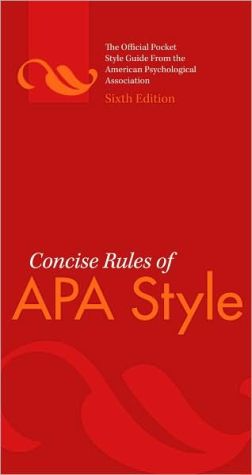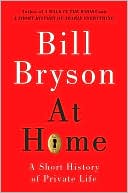Concise Rules of APA Style
An easy-to-use, pocket guide for quickly looking up the rules of APA Style. It offers writers a comprehensive list of essential writing standards in a convenient, easily retrievable format. It also provides suggestions for eliminating errors in writing and reducing bias in language and guidance on the construction of references and formatting of tables, figures, and appendices. \ This easy-to-use pocket guide, compiled from the Publication Manual of the American Psychological Association,...
Search in google:
Where do you put the notes to a table? What is the difference between "g" and "g"? How do you cite a work discussed in a secondary source? Along with answering these and other questions that always seem to arise about six minutes before deadline, this reference also gives information on organizing ideas into an acceptable form and reducing bias in language. Compiled from the fifth edition of the Publication Manual of the American Psychological Association, this pocket guide includes information on punctuation (for those who confuse slashes with hyphens), capitalization (for those who confuse newtons and watts with Newton and Watt), spelling (for all of us), italicizing, and abbreviating, as well as advice on presenting statistics, tables, figures, quotations, citations, footnotes and appendices (it prefers "appendixes"). It also provides very helpful reference examples, including those from electronic and audiovisual media, a cross-reference to the publication manual and a checklist for manuscript submission. Annotation ©2004 Book News, Inc., Portland, OR Doody Review Services Reviewer:Nicholas Greco IV, MS, BCETS, CATSM(Abbott Laboratories)Description:Authors will be most pleased with this sixth edition of a handy and portable guide to APA style. Purpose:The purpose of this edition is to simplify APA heading style and make it more conducive to electronic publication. This edition also includes updated guidelines for reducing bias in language to reflect current practices and preferences. Good and bad language choices have been expanded and moved to the web.Audience:Every researcher, clinician, and student who must use APA style in their papers, reports, and journal articles must have a copy of this pocket guide.Features:This book targets only the rules that writers clearly need in order to choose the best words and format for their articles. It is an abridged, yet relevant guide to APA style. The convenient format makes it much simpler to use every day.Assessment:This is a wonderful, handy desk reference that belongs on the desk of every writer using APA style.
Contents Introduction: A Pocket Reference for Writers 1. Concise and Bias-Free Writing General Guidance Orderly Presentation of Ideas Smoothness of Expression Economy of Expression Precision and Clarity Grammar Verbs Agreement of Subject and Verb Pronouns Misplaced and Dangling Modifiers and Use of Adverbs Relative Pronouns and Subordinate Conjunctions Parallel Construction Linguistic Devices Reducing Bias in Language Guideline 1: Describe at an Appropriate Level of Specificity Guideline 2: Be Sensitive to Labels Guideline 3: Acknowledge Participation Gender Sexual Orientation Racial and Ethnic Identity Disabilities Age Organizing Ideas Organizing a Manuscript With Headings Levels of Heading Selecting the Levels of Heading 2. Punctuation, Spelling, and Capitalization Punctuation Period Comma Semicolon Colon Dash Quotation Marks Parentheses Brackets Slash Spelling Preferred Spelling Hyphenation Capitalization Words Beginning a Sentence Major Words in Titles and Headings Proper Nouns and Trade Names Nouns Followed by Numerals or Letters Titles of Tests Names of Conditions or Groups in an Experiment Names of Factors, Variables, and Effects 3. Italicizing and Abbreviating Italics Italicizing Words Abbreviations Use of Abbreviations Explanation of Abbreviations Abbreviations Accepted as Words Abbreviations Used Often in APA Journals Latin Abbreviations Scientific Abbreviations Other Abbreviations Use of Periods With Abbreviations Plurals of Abbreviations Abbreviations Beginning a Sentence 4. Numbers, Metrication, and Statistics Numbers Seriation Numbers Expressed in Figures Numbers Expressed in Words Combining Figures and Words to Express Numbers Ordinal Numbers Decimal Fractions Roman Numerals Commas in Numbers Plurals of Numbers Metrication Policy on Metrication Style for Metric Units Statistical and Mathematical Copy Selecting the Method of Analysis and Retaining Data Selecting Effective Presentation References for Statistics Formulas Statistics in Text Statistical Symbols Spacing, Alignment, and Punctuation Equations in Text Displayed Equations 5. TablesTabular Versus Textual Presentation Relation of Tables and Text Relation Between Tables Table Numbers Table Titles Headings Body of a Table Presenting Data in Specific Types of Tables Notes to a Table Ruling of Tables Size of Tables Tables From Another Source Table Checklist 6. Figures Deciding to Use Figures Standards for Figures Types of Figures Line Art Versus Halftone Overall Size and Proportion Preparation of Figures Creating Graphs Using Photographs Identifying and Citing Figures Figure Legends and Captions Submitting Figures Figure Checklist 7. Footnotes and Appendixes Footnotes Footnotes in Text Notes to Tables Author Note Appendixes Identifying and Citing Appendixes Body and Headings Tables as Appendixes Tests and Questionnaires 8. Quotations, Reference Citations in Text, and Reference List Quotations Quotation of Sources Accuracy Double or Single Quotation Marks Changes From the Source Requiring No Explanation Changes From the Source Requiring Explanation Citation of Sources Citations Within Quotations Permission to Quote Plagiarism Reference Citations in Text Agreement of Text and Reference List One Work by One Author One Work by Multiple Authors Groups as Authors Works With No Author (Including Legal Material) or With an Anonymous Author Authors With the Same Surname Two or More Works Within the Same Parentheses Classical Works Specific Parts of a Source Personal Communications Citations in Parenthetical Material Reference List Construction of an Accurate and Complete Reference List APA Reference Style Order of References in the Reference List References Included in a Meta-Analysis Introduction to APA Reference Style General Forms Authors Publication Date Title of Article or Chapter Title of Work and Publication Information: Periodicals Title of Work: Nonperiodicals Title of Work: Part of a Nonperiodical (Book Chapters) Publication Information: Nonperiodicals Retrieval Information: Electronic Sources 9. Reference Examples A. Periodicals B. Books, Brochures, and Book Chapters C. Technical and Research Reports D. Proceedings of Meetings and Symposia E. Doctoral Dissertations and Master's Theses F. Unpublished Work and Publications of Limited Circulation G. Reviews H. Audiovisual Media I. Electronic Media Sources on the Internet Periodicals on the Internet Internet Articles Based on a Print Source Article in an Internet-Only Journal Article in an Internet-Only Journal, Retrieved Via File Transfer Protocol Article in an Internet-Only Newsletter Nonperiodical Documents on the Internet Multipage Document Created by Private Organization, No Date Chapter or Section in an Internet Document Stand-Alone Document, No Author Identified, No Date Document Available on University Program or Department Web Site Technical and Research Reports on the Internet Report From a University, Available on Private Organization Web Site U.S. Government Report Available on Government Agency Web Site, No Publication Date Indicated Report From a Private Organization, Available on Organization Web Site Abstract of a Technical Report Retrieved From University Web Site Proceedings of Meetings and Symposia on the Internet Paper Presented at a Symposium, Abstract Retrieved From University Web Site Paper Presented at a Virtual Conference E-Mail Newsgroups, Online Forums and Discussion Groups, and Electronic Mailing Lists Message Posted to a Newsgroup Message Posted to Online Forum or Discussion Group Message Posted to an Electronic Mailing List Other Electronic Sources Aggregated Databases Electronic Copy of a Journal Article, Three to Five Authors, Retrieved From Database Daily Newspaper Article, Electronic Version Available by Search Electronic Copy of an Abstract Obtained From a Secondary Database Electronic Version of U.S. Government Report Available by Search From GPO Access Database (on the Web) Computer Programs, Software, and Programming Languages Computer Software Computer Software and Manual Available on University Web Site Raw Data Data File, Available From Government Agency Data File, Available From NTIS Web Site References Appendix A. Style Rules Cross-Referenced to the Fifth Edition of the Publication Manual of the American Psychological Association Checklist for Manuscript Submission
\ Reviewer: Nicholas Greco IV, MS, BCETS, CATSM(Abbott Laboratories)\ Description: Authors will be most pleased with this sixth edition of a handy and portable guide to APA style. \ Purpose: The purpose of this edition is to simplify APA heading style and make it more conducive to electronic publication. This edition also includes updated guidelines for reducing bias in language to reflect current practices and preferences. Good and bad language choices have been expanded and moved to the web.\ Audience: Every researcher, clinician, and student who must use APA style in their papers, reports, and journal articles must have a copy of this pocket guide.\ Features: This book targets only the rules that writers clearly need in order to choose the best words and format for their articles. It is an abridged, yet relevant guide to APA style. The convenient format makes it much simpler to use every day.\ Assessment: This is a wonderful, handy desk reference that belongs on the desk of every writer using APA style.\ \








